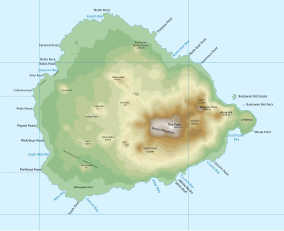Boatswain Bird Island
| Boatswain Bird Island Sanctuary | |
|---|---|
 Boatswain Bird Island Sanctuary | |
 Boatswain Bird Island is the small 5.3 ha (13 acres) island off the east coast of Ascension Island | |
| Location | Saint Helena, Ascension and Tristan da Cunha |
| Coordinates | 7°56′09″S 14°18′27″W / 7.93583°S 14.30750°W |
This article needs additional citations for verification. (October 2022) |


Boatswain Bird Island, also spelt Boatswainbird Island, is a small island some 270 metres (300 yd) off the east coast of Ascension Island in the South Atlantic Ocean with an area of approximately 5.3 ha (13 acres).[citation needed] It is administered from Georgetown on Ascension, which is part of Saint Helena, Ascension and Tristan da Cunha, an overseas territory of the United Kingdom. Boatswain Bird Island should not be confused with the nearby, much smaller, Boatswain Bird Rock, only about 10 by 5 metres (33 by 16 ft) in size, located 570 metres (620 yd) south-east of the island and 360 metres (390 yd) north-east of the coast of Ascension. The southern coast of the island has an impressive natural arch.[citation needed]
Birds
[edit]There are thousands of inhabitants on this tiny island, all of which are birds, which give the island its white colour. Among the many seabirds nesting there are boobies, petrels, noddies, as well as the tropicbirds (boatswain birds) for which the island is named.[citation needed]
The island is the home of the majority of Ascension's birds due to rats (accidentally introduced by passing ships) and then cats (introduced to catch the rats, as well as pets) eating the birds and their eggs on Ascension.[citation needed] Since the mid-1990s there has been a feral cat eradication program, alongside a rat eradication program, to encourage the birds back to the main island.[citation needed]
Important Bird Area
[edit]The island has been identified as an Important Bird Area (IBA) by BirdLife International as a breeding site for seabirds. Birds for which the IBA is significant include Madeiran storm petrels (1,500 breeding pairs), red-billed tropicbirds (500 pairs), white-tailed tropicbirds (1,000 pairs), Ascension frigatebirds (6,000 pairs), masked boobies (1,300 pairs) and black noddies (5,000 pairs).[1]
References
[edit]- ^ "Boatswainbird Island". Important Bird Areas factsheet. BirdLife International. 2012. Archived from the original on 10 July 2007. Retrieved 25 October 2012.
